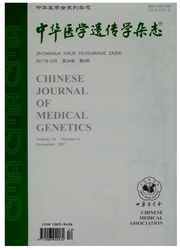

 中文摘要:
中文摘要:
目的对2例常规细胞遗传学漏诊的嵌合型9三体进行诊断。方法应用CytoScan^TM HD基因芯片对1例智力低下患儿的外周血基因组进行分析,采用荧光原位杂交(fluorescence in situ hybridization,FISH)对2例患者的培养前后间期细胞进行9三体检测。结果例1经单核苷酸多态性微阵列(single nucleotide polymorphism array,SNP array)分析,显示9号染色体拷贝数嵌合性增加。FISH分析例1培养前9三体细胞占40%,培养后9三体细胞占15%;例2脐血细胞培养前9三体细胞占35%,培养后9三体细胞占10%。结论SNP-Array芯片可以检测常规细胞遗传学无法检测到的低水平的嵌合体,FISH结合已知的核型分析或芯片分析可以明确诊断嵌合型三体,产前诊断中经典细胞遗传学结合SNP-array或FISH可以鉴别真假嵌合体,可为产前诊断提供更全面准确的遗传咨询。
 英文摘要:
英文摘要:
Objective To detect mosaic trisomy 9 missed by conventional cytogenetics. Methods Peripheral blood genomic DNA from a girl with mental retardation was analyzed using Affymetrix CytoScanTM HD array. Fluorescence in situ hybridization (FISH) was also performed on samples from two patients. Results The SNP-array analysis has revealed multiple duplications along chromosome 9. FISH analysis showed that, for the peripheral blood sample from one patient, 40 of 100 interphase cells and 15 of 100 metaphase cells carried trisomy 9. For the cord blood sample from another patient, 35 of 100 interphase cells and 10 of 100 cultured cells carried trisomy 9. Conclusion SNP-array is useful for detecting low-level mosaicism which may be missed by conventional cytogenetics. Combined with karyotype and mieroarray analyses, FISH is a focused and targeted approach for diagnosing mosaic trisomy. They may provide a useful tool for differentiating pseudomosaicisms from true mosaicisms.
 同期刊论文项目
同期刊论文项目
 同项目期刊论文
同项目期刊论文
 期刊信息
期刊信息
